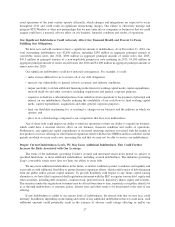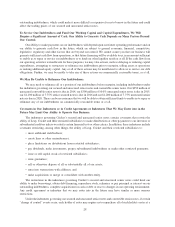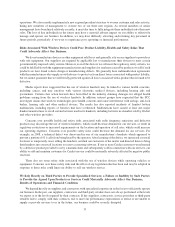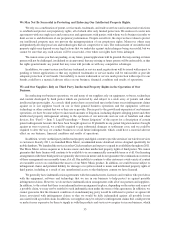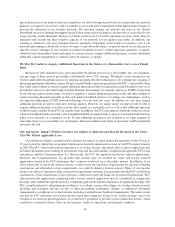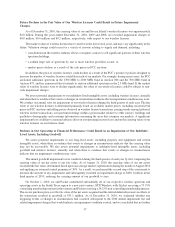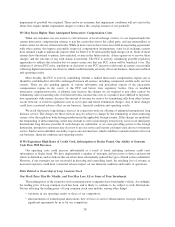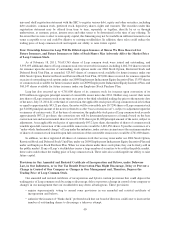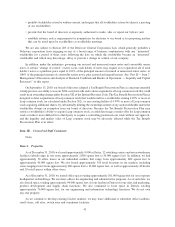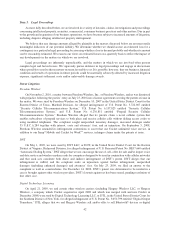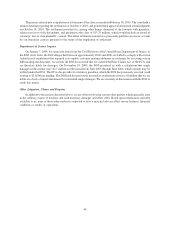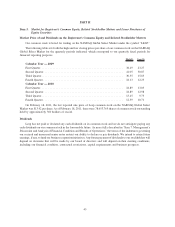Cricket Wireless 2010 Annual Report Download - page 41
Download and view the complete annual report
Please find page 41 of the 2010 Cricket Wireless annual report below. You can navigate through the pages in the report by either clicking on the pages listed below, or by using the keyword search tool below to find specific information within the annual report.copyright exemption facilitates our current practice of allowing customers to bring in unlocked, or “reflashed,”
phones that they already own and may have used with another wireless carrier, and activate them on our network. To
the extent that the Copyright Office determines in the future not to extend this exemption for an extended period of
time and this prevents us from “flashing” devices or activating “reflashed” devices on our network, this could have a
material adverse impact on our business, financial condition and results of operations.
We also are subject, or potentially subject, to numerous additional rules and requirements, including universal
service obligations; number portability requirements; number pooling rules; rules governing billing, subscriber
privacy and customer proprietary network information; roaming obligations; rules that require wireless service
providers to configure their networks to facilitate electronic surveillance by law enforcement officials; rate
averaging and integration requirements; rules governing spam, telemarketing and truth-in-billing; and rules
requiring us to offer equipment and services that are accessible to and usable by persons with disabilities,
among others. There are also pending proceedings exploring the imposition of various types of nondiscrimination,
open access and broadband management obligations on our devices and networks; the prohibition of device
exclusivity; the possible re-imposition of bright-line spectrum aggregation requirements; further regulation of
special access used for wireless backhaul services; and the effects of the siting of communications towers on
migratory birds, among others. Some of these requirements and pending proceedings (of which the foregoing
examples are not an exhaustive list) pose technical and operational challenges to which we, and the industry as a
whole, have not yet developed clear solutions. These requirements generally are the subject of pending FCC or
judicial proceedings, and we are unable to predict how they may affect our business, financial condition or results of
operations.
In addition, certain states in which we provide service are considering legislation that would require companies
selling prepaid wireless services to verify a customer’s identity using government identification. Although we
request identification from new customers, we currently do not require them to provide identification in order to
initiate service with us, and such a requirement could adversely impact our ability to attract new customers for our
services.
Our operations are subject to various other laws and regulations, including those regulations promulgated by
the Federal Trade Commission, the Federal Aviation Administration, the Environmental Protection Agency, the
Occupational Safety and Health Administration, other federal agencies and state and local regulatory agencies and
legislative bodies. Adverse decisions or regulations of these regulatory bodies could negatively impact our
operations and costs of doing business. Because of our smaller size, legislation or governmental regulations
and orders can significantly increase our costs and affect our competitive position compared to other larger
telecommunications providers. We are unable to predict the scope, pace or financial impact of regulations and other
policy changes that could be adopted by the various governmental entities that oversee portions of our business.
If Customer Usage of Our Services Exceeds Our Expectations, Our Costs of Providing Service Could
Increase, Which Could Have a Material Adverse Effect on Our Operating Expenses.
Our most popular Cricket Wireless service plans bundle certain features with unlimited local and U.S. long
distance service and unlimited text messaging, along with mobile web, 411 services, navigation and data back-up,
for a fixed monthly fee to more effectively compete with other telecommunications providers. In August 2010, we
introduced “smartphones” and other new devices which use greater amounts of network capacity than the handsets
and devices we previously offered. We also offer Cricket Broadband, our unlimited mobile broadband service, and
Cricket PAYGo, a pay-as-you-go unlimited prepaid wireless service. In early 2011, we launched Muve Music, an
unlimited music download service designed specifically for mobile handsets, in select Cricket markets, and we
expect to expand its availability throughout 2011. We provide nationwide voice, data and mobile broadband
wireless services through our own Cricket network footprint and through roaming and wholesale agreements that
we have entered into with other carriers. Cricket Wireless customers generally use their handsets for voice calls for
an average of approximately 1,500 minutes per month, and some markets experience substantially higher call
volumes. Customer usage of our Cricket Broadband service has also been significant.
If customers exceed expected usage for our voice, data, mobile broadband or music download services, we
could face capacity problems and our costs of providing the services could increase. Although we own less
35




